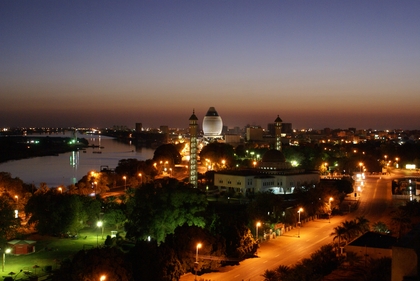Khartoum
Khartoum or Khartum (/kɑːrˈtuːm/ kar-TOOM;[5][6] Arabic: الخرطوم, romanized: Al-Khurṭūm) is the capital city of Sudan. It is also Sudan's largest city. It is where the Blue Nile and main Nile come together. Its name means "elephant tusk". Two other cities nearby are Omdurman and Khartoum North.
Khartoum
الخرطوم | |
|---|---|
Capital city | |
From top: Night View of Khartoum, Khartoum Mosque, the University of Khartoum, and the El Mek Nimr Bridge. | |
| Nickname: "Triangular Capital" | |
| Coordinates: 15°30′2″N 32°33′36″E / 15.50056°N 32.56000°E[1] | |
| Country | |
| State | Khartoum |
| Area | |
| • Capital city | 1,010 km2 (390 sq mi) |
| Elevation | 381 m (1,250 ft) |
| Population | |
| • Capital city | 639,598 |
| • Urban | 6,017,000 |
| • Metro | 5,274,321 |
| Demonyms | Khartoumese, Khartoumian (the latter more properly designates a Mesolithic archaeological stratum) |
| Time zone | UTC+2 (CAT) |
Khartoum has a hot desert climate (BWh in the Koeppen climate classification).
Climate
changeKhartoum has a hot desert climate (Köppen climate classification BWh). It is very dry in the winter. This is normal in the Saharo-Sahelian zone. The climate is very dry for most of the year. In eight months of the year, the average rainfall is less than 5 mm (0.20 in) of rain.
In August, there is a little bit of rain. The most amount of rainfall in this month is about 48 mm (1.9 in). The rainy season is usually windy. The average amount of rainfall is very low. There is only 121.3 mm (4.78 in) of precipitation on average in a year. The highest temperatures usually are during two main parts of the year. The first is in the late dry season when the temperatures are usually above 40 °C (104 °F) from April to June. The second is in the early dry season. Here, the average highs are above 39 °C (102 °F) in September and October. Temperatures are usually colder in the night. The lowest average low temperature in the year in January is just above 15 °C (59 °F). Khartoum is one of the hottest major cities on Earth. It has an annual mean temperature of 30 °C (86 °F). In most months, the monthly average temperatures doesn't get below 30 °C (86 °F). This is usually not seen in any other majors cities with hot desert climates like Riyadh, Baghdad and Phoenix.[7]
| Climate data for Khartoum (1971–2000) | |||||||||||||
|---|---|---|---|---|---|---|---|---|---|---|---|---|---|
| Month | Jan | Feb | Mar | Apr | May | Jun | Jul | Aug | Sep | Oct | Nov | Dec | Year |
| Record high °C (°F) | 39.7 (103.5) |
42.5 (108.5) |
45.2 (113.4) |
46.2 (115.2) |
46.8 (116.2) |
46.3 (115.3) |
44.5 (112.1) |
43.5 (110.3) |
44.0 (111.2) |
43.0 (109.4) |
41.0 (105.8) |
39.0 (102.2) |
46.8 (116.2) |
| Average high °C (°F) | 30.7 (87.3) |
32.6 (90.7) |
36.5 (97.7) |
40.4 (104.7) |
41.9 (107.4) |
41.3 (106.3) |
38.5 (101.3) |
37.6 (99.7) |
38.7 (101.7) |
39.3 (102.7) |
35.2 (95.4) |
31.7 (89.1) |
37.0 (98.6) |
| Daily mean °C (°F) | 23.2 (73.8) |
25.0 (77.0) |
28.7 (83.7) |
31.9 (89.4) |
34.5 (94.1) |
34.3 (93.7) |
32.1 (89.8) |
31.5 (88.7) |
32.5 (90.5) |
32.4 (90.3) |
28.1 (82.6) |
24.5 (76.1) |
29.9 (85.8) |
| Average low °C (°F) | 15.6 (60.1) |
16.8 (62.2) |
20.3 (68.5) |
24.1 (75.4) |
27.3 (81.1) |
27.6 (81.7) |
26.2 (79.2) |
25.6 (78.1) |
26.3 (79.3) |
25.9 (78.6) |
21.0 (69.8) |
17.0 (62.6) |
22.8 (73.0) |
| Record low °C (°F) | 8.0 (46.4) |
8.6 (47.5) |
12.6 (54.7) |
12.7 (54.9) |
18.5 (65.3) |
20.2 (68.4) |
17.8 (64.0) |
18.0 (64.4) |
17.7 (63.9) |
17.5 (63.5) |
11.0 (51.8) |
6.2 (43.2) |
6.2 (43.2) |
| Average precipitation mm (inches) | 0.0 (0.0) |
0.0 (0.0) |
0.1 (0.00) |
0.0 (0.0) |
3.9 (0.15) |
4.2 (0.17) |
29.6 (1.17) |
48.3 (1.90) |
26.7 (1.05) |
7.8 (0.31) |
0.7 (0.03) |
0.0 (0.0) |
121.3 (4.78) |
| Average precipitation days (≥ 0.1 mm) | 0.0 | 0.0 | 0.1 | 0.0 | 0.9 | 0.9 | 4.0 | 4.2 | 3.4 | 1.2 | 0.0 | 0.0 | 14.7 |
| Average relative humidity (%) | 27 | 22 | 17 | 16 | 19 | 28 | 43 | 49 | 40 | 28 | 27 | 30 | 29 |
| Mean monthly sunshine hours | 316.2 | 296.6 | 316.2 | 318.0 | 310.0 | 279.0 | 269.7 | 272.8 | 273.0 | 306.9 | 303.0 | 319.3 | 3,580.7 |
| Mean daily sunshine hours | 10.2 | 10.5 | 10.2 | 10.6 | 10.0 | 9.3 | 8.7 | 8.8 | 8.1 | 9.9 | 10.1 | 10.3 | 9.8 |
| Source 1: World Meteorological Organisation,[8] NOAA (extremes and humidity 1961–1990)[9] | |||||||||||||
| Source 2: Deutscher Wetterdienst (sun, 1961–1990)[10] | |||||||||||||
Demographics
change| Year | Population | |
|---|---|---|
| City | Metropolitan area | |
| 1907[11] | 69,349 | n.a. |
| 1956 | 93,100 | 245,800 |
| 1973 | 333,906 | 748,300 |
| 1983 | 476,218 | 1,340,646 |
| 1993 | 947,483 | 2,919,773 |
| 2008 Census Preliminary | 3,639,598 | 5,274,321 |
Almost 250,000 Syrians lived in Khartoum in 2019, representing 5% of all of the people in the city. Most of the population are young men who have fled war in Syria. Sudan was the only country in the world to accept travelers that has a Syrian passport but didn't have a visa.[12]
Related pages
changeReferences
change- ↑ 1.0 1.1 "Where is Khartoum, The Sudan?". worldatlas.com. 2018. Retrieved 2018-01-28.
- ↑ "Sudan: States, Major Cities, Towns & Agglomeration - Population Statistics, Maps, Charts, Weather and Web Information". www.citypopulation.de.
- ↑ "Sudan Facts on Largest Cities, Populations, Symbols - Worldatlas.com". www.worldatlas.com. 7 April 2017. Retrieved 9 February 2018.
- ↑ Demographia World Urban Areas (PDF) (17th ed.). Demographia. May 2021. p. 42. Retrieved 8 May 2021.
- ↑ "Khartoum". Dictionary.reference.com.
- ↑ "Khartoum". TheFreeDictionary.com.
- ↑ Peel, M. C.; B. L. Finlayson; T. A. McMahon (2007). "Updated world map of the Köppen-Geiger climate classification" (PDF). Hydrology and Earth System Sciences. 11 (5): 1633–1644. Bibcode:2007HESS...11.1633P. doi:10.5194/hess-11-1633-2007.
- ↑ "World Weather Information Service – Khartoum". World Meteorological Organization. Archived from the original on 6 February 2017. Retrieved 6 May 2010.
- ↑ "Khartoum Climate Normals 1961–1990". National Oceanic and Atmospheric Administration. Retrieved 16 January 2014.
- ↑ "Klimatafel von Khartoum / Sudan" (PDF). Baseline climate means (1961-1990) from stations all over the world (in German). Deutscher Wetterdienst. Archived from the original (PDF) on 5 March 2017. Retrieved 22 October 2016.
- ↑ Chisholm, Hugh, ed. (1911). . Encyclopædia Britannica. Vol. 15 (11th ed.). Cambridge University Press. p. 773.
- ↑ Tobin, Sarah A. (13 November 2019). "The New Lost Boys of Sudan". The Project on Middle East Political Science. Retrieved 4 December 2020.







